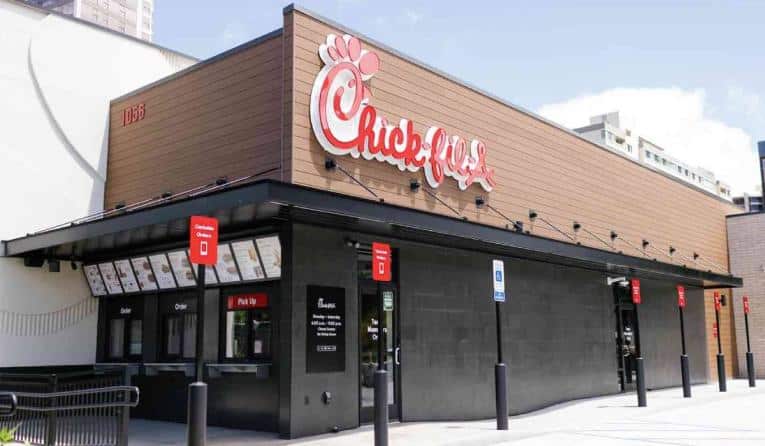Chick-fil-A began its Hawaii expansion in September with a Kahului, Maui, location, and goals to open “several restaurants” in the Aloha State over the next five years. That plan will now include a drive-thru-focused location (with no seating), which is set to debut Thursday in O‘ahu. The store features two drive-thru lanes and three walk-up windows for pedestrians. A Chick-fil-A employee will great the walk-up guest face-to-face and take their order for carryout. Third-party delivery will be available in the “near future” as well.
Chick-fil-A said the restaurant’s focus will center on “expediting and elevating the experience for guests with innovation, speed, and hospitality.” Employees, like typical drive-thrus across the brand, will walk the line and take orders on a tablet. As the order-taker navigates the queue, another team member will come to the customer’s car to accept payment, “allowing vehicles to move through more quickly than they do at a traditional speaker box drive-thru,” Chick-fil-A said.
The chain partnered with clothing brands, it added, on cooling vests and moisture-wicking uniforms for workers.
Chick-fil-A noted the unit would require roughly 150 full- and part-time employees to staff. It will be run by O‘ahu-raised Zane Dydasco, who grew up 10 minutes from the restaurant. He was introduced to Chick-fil-A from a classmate at the United States Air Force Academy. Dydasco served for nearly a decade.
Chick-fil-A’s ability to expedite cars through the drive-thru has been one of the lead topics in QSR’s Drive-Thru Report in recent years. In 2022, Chick-fil-A finished at the bottom of the pack in average service time, clocking 325.47 seconds. However, context told a much different story. Firstly, Chick-fil-A was given a 93 percent for speed of service satisfaction in the survey portion of the report. So guests didn’t appear to consider the brand “slow” by any stretch, stopwatch or not.
In truth, there are a few realities at work. The clearest one is Chick-fil-A continues to be busier than its counterparts (more cars in line equals longer waits). In the report, for vehicles in line at drive-thrus, numbers flip going up. Chick-fil-A begins at the bottom—only 11 percent of the time a driver pulled up were there no cars ahead—and rockets ahead at the five-car mark. There, shoppers saw five vehicles lined up nearly 11 percent of the time. The closest brand was McDonald’s and Burger King at 4 percent.
The most telling stat, though, was the 10-plus cars metric. There, Intouch Insight mystery shopper data discovered lines of that length and longer 16 percent of the time at Chick-fil-A. McDonald’s followed at 2 percent, while Arby’s and Wendy’s each notched 1 percent. Everybody else was at zero.
The average cars in line went as follows: Chick-fil-A, 5.45; McDonald’s, 3.13; Wendy’s, 2.67; Arby’s, 2.28; Burger King, 2.19; Taco Bell, 2.17; Dunkin’, 2.11; KFC, 1.8; Hardee’s, 1.64; and Carl’s Jr. 1.63.
And then there’s Chick-fil-A’s “perception” of speed that surfaced in the survey. When it came to average total time by cars in line (how fast each car moved), Chick-fil-A led the chains, meaning it’s serving cars quicker than anybody else.
- 1. Chick-fil-A: 107.41 (seconds)
- 2. McDonald’s: 118
- 3. Taco Bell: 127.58
- 4. Arby’s: 139.92
- 5. Dunkin’: 140.21
- 6. Wendy’s: 141.67
- 7. Burger King: 147.43
- 8. KFC: 142.84
- 9. Hardee’s: 180.21
- 10. Carl’s Jr. 193.6
The other part is where Chick-fil-A’s drive-thru experience actually begins from a timing perspective. The brand, as it pointed out with the new opening, takes orders via tablets face-to-face in-line when cars pull up instead of a speakerbox. So there’s generally little to no waiting behind a group just to get your order in—the waiting happens after the fact. And it conducts hospitality checkpoints of sorts (like taking payment with a different employee) so the experience feels connected throughout. It’s not all that different from when a server at a full-service restaurant conducts multiple table checks versus taking an order and disappearing for 30 minutes. “We believe that looking eye-to-eye with the customer allows for a connection that happens at the beginning of the drive-thru,” Matt Abercrombie, Chick-fil-A’s senior director of service and hospitality, previously told QSR.
READ MORE: Chick-fil-A Served 527 Million Chicken Sandwiches in 2022
Regardless, Chick-fil-A’s decision to lean further into what’s become a growing industry movement—drive-thru-only stores—aligns with the numbers. The brand generated $18.814 billion in U.S. sales across 2022, a figure that trailed only McDonald’s ($48.7 billion) and Starbucks ($28.1 billion). In 2019, the chain earned $12.2 billion and bumped to $13.7 billion and $16.67 billion in the ensuing years. Total revenue and income climbed from $4.32 billion to $6.37 billion. But key to this directive—average-unit volumes at freestanding drive-thrus ended 2022 at $8.676 million, up from $8.142 million and $7.096 million in 2021 and 2020, respectively.
In this pool of 1,925 counted units, 919, or 48 percent, hit that $8.76 million mark or higher. One operator pulled in $16.985 million. Roughly 34 percent reported annual sales volumes less than $7.6 million. About 33 percent fell between $7.6 and $9.5 million. And, in maybe the most pulsing stat, 33 percent of operators in this freestanding field generated annual sales volumes north of $9.5 million.
Mall stores, or units sans drive-thrus, in 2022 were closer to $2.7 million.
For licensed units located on college or university campuses that were open at least one year as of December 31, 2022, it was $926,127 and AUV was $1.107 million.
Chick-fil-As in hospitals, businesses, industries or airports generated AUVs of $2.481 million. This ranged as high as $10.065 million and as low as $72,747.









